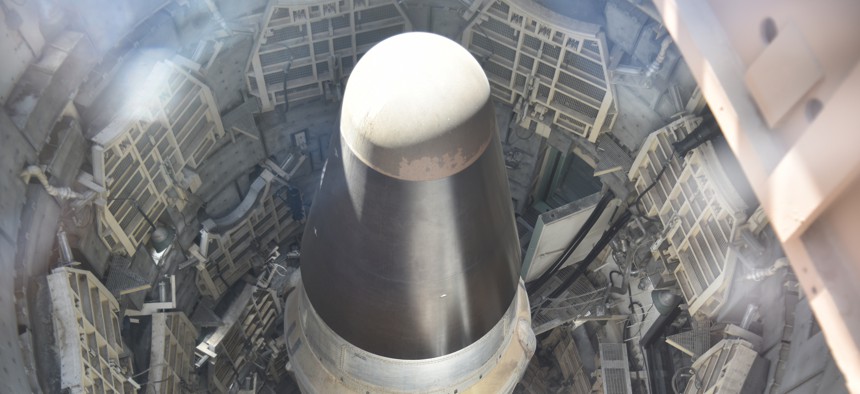
Inert Titan ICBM at the ready in the launch silo at the Titan II museum in Arizona. Paul R. Jones / Shutterstock
Who Needs ICBMs?
Spend the money on the other two legs of the nuclear triad, and improve global stability and U.S. security.
The recent news that Boeing will not bid to build the U.S. Air Force’s next-generation ICBM sent ripples of concern throughout the defense world. Absent Boeing’s participation, Northrop Grumman will have no competition for the contract on one of the biggest replacement programs in the U.S. nuclear modernization plan. The Pentagon’s plan is already expensive enough: an estimated $1.5 trillion (with inflation) over the next three decades, according to the latest assessment by the Congressional Budget Office. Without competition, that massive figure is only likely to rise.
But the concern about Boeing’s withdrawal from the Ground Based Strategic Deterrent competition raises a larger question. Does the United States even need ICBMs for its defense?
An alternative nuclear posture devised by the organization Global Zero answers that question with an emphatic “no.”
Related: Consider a National-Team Approach to the Next ICBM
Related: New Nuclear Missiles' Cost Estimate Changes Again
Related: Russia Claims To Be On Track to Deploy a Maneuverable ICBM Next Year
The Global Zero plan would shift U.S. nuclear strategy from one that engages in planning for elaborate and dangerous nuclear warfighting to one that establishes the nuclear arsenal as a second-strike force meant to deter nuclear attacks against the U.S. and its allies – a “deterrence-only” strategy. This could be achieved with five new ballistic missile submarines and a backup force of 40 nuclear-capable bombers – a total of 640 deployed nuclear weapons and 450 in reserve. The new approach would be grounded in a policy of no first use of nuclear weapons, which would provide a critical margin of safety against the rash or accidental launch of nuclear weapons in a crisis.
An estimate by the Center for International Policy’s Sustainable Defense Task Force suggests that an approach along the lines proposed by Global Zero could save over $100 billion over the next decade – money that could be used for other urgent national needs. Part of the savings could be used to improve the nation’s vulnerable nuclear command, control and communication systems, elements critical to a survivable and credible deterrent.
Based on analysis of credible estimates of Pentagon nuclear planning, Global Zero found that a no-first-use policy would improve global stability and U.S. security, reducing the risk of nuclear war without diminishing the United States’ ability to deter nuclear threats to or attacks on itself or its allies. But in order to show commitment to such a policy, the U.S. would need to go beyond words; it would need also to change to the U.S. nuclear force structure and move away from a first-strike posture. Taking ICBMs off high alert and phasing them out over the next ten years would not only improve no-first-use credibility and transparency, it would increase presidential launch decision time – which could now be as short as six minutes – thereby reducing the risk of nuclear use.
The U.S. Air Force has 400 ICBMs sitting in silos in the middle of the country on high alert, ready to launch within minutes of receiving the order, vulnerable to an incoming nuclear first strike. U.S. officials, who are still working from the Cold War playbook, argue that they provide an opportunity cost for an adversary who would need to “waste” nuclear weapons on ICBMs so the U.S. can’t use them to retaliate. Not only is each silo a target for a potential enemy, it’s also an incentive for the U.S. to use these weapons before they lose them, encouraging preemptive use in a conflict or launch on warning of an incoming attack. There is already a record of instances of false alarms, from a flock of geese to a computer chip malfunction to the exercise mistaken for a real alert in Hawaii last year.
The dangers presented by “use or lose” ICBMs are compounded by their redundancy. Ballistic missile submarines – the most survivable leg of the nuclear arsenal, virtually undetectable at sea with no known credible threat – can provide a credible deterrent force. As a hedge against future advances in anti-submarine capabilities, the United States would keep a reserve force of bombers. ICBMs are simply unnecessary. Moreover, U.S. planners can look for more non-nuclear options as they forge their war plans. Conventional and cyber options are better suited to hit certain targets traditionally reserved for nuclear weapons, and encourage de-escalation of a conflict before it crosses the nuclear threshold. Any military value ICBMs may have held in the past is now outweighed by the inherent risk of use – by accident, miscalculation or on false warning of an incoming attack.
The Global Zero view on ICBMs is shared by former Defense Secretary William Perry, who has said “These missiles are some of the most dangerous weapons in the world. They could even trigger an accidental nuclear war.”
Congress has resisted even modest changes in the ICBM force, including a recent amendment by Rep. Earl Blumenauer, D-Oregon, that would have authorized an independent study on options to extend the life of current generation ICBMs and delay the development of new ones.
But there are signs of openness. House Armed Services Chairman Adam Smith, D-Washington, has encouraged dialogue about future U.S. nuclear strategy and force posture, including declaratory policy and phasing out ICBMs. He held a hearing on the subject in March 2019, and he has introduced legislation to make it United States policy that it will “not use nuclear weapons first.” Sen. Elizabeth Warren, D-Massachusetts, introduced a companion bill in the Senate. After decades of adherence to a nuclear warfighting strategy, Congress should take every opportunity to consider saner, safer alternatives.



